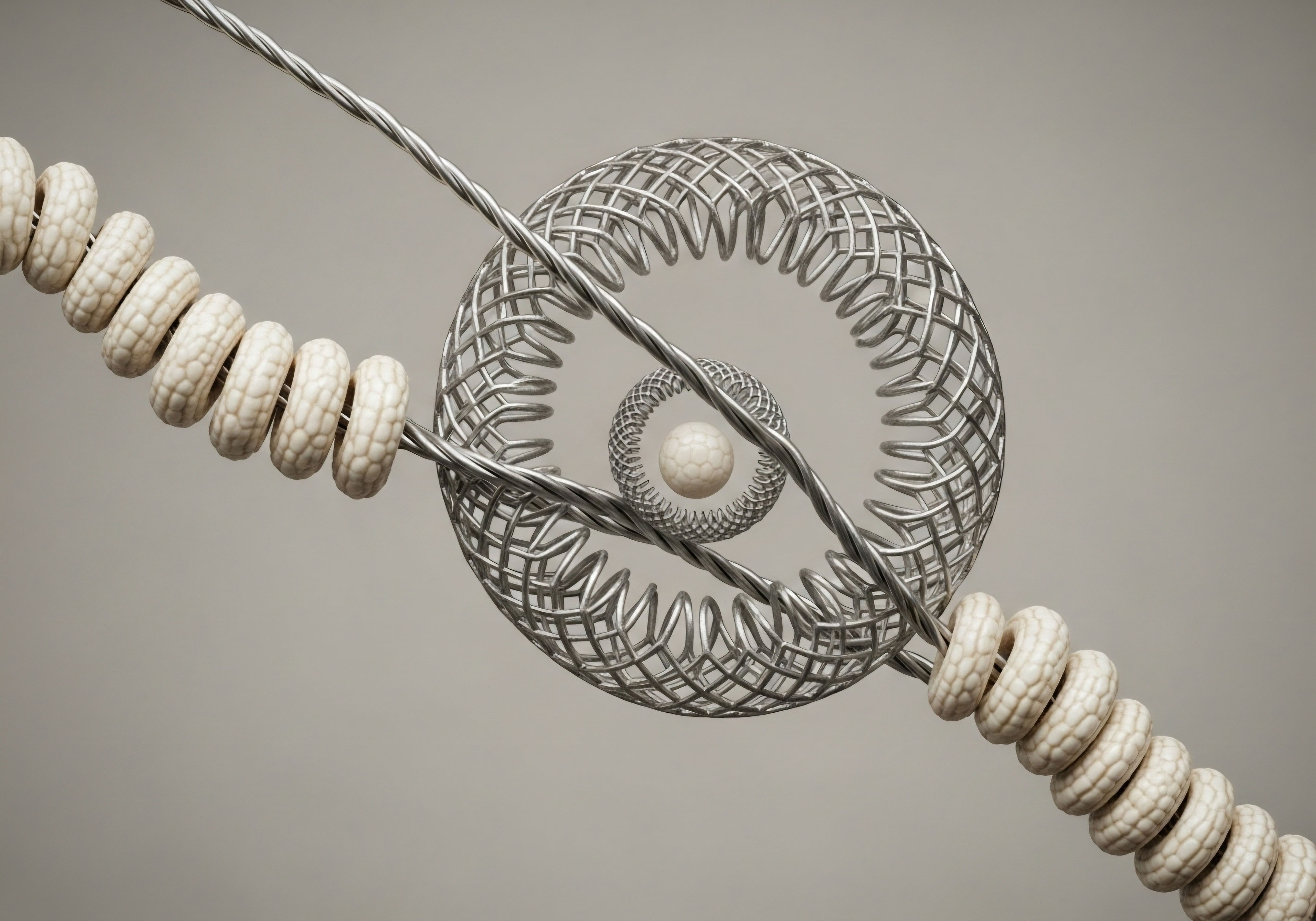

Fundamentals
Have you ever felt a subtle shift within your own being, a gradual erosion of the vitality that once defined your days? Perhaps a persistent fatigue, a diminished drive, or a sense that your body’s internal rhythms are simply out of sync.
Many individuals experience these sensations, often attributing them to the inevitable march of time or the stresses of modern life. Yet, these feelings frequently signal deeper biological conversations occurring within your endocrine system, the intricate network responsible for producing and regulating the very messengers that govern nearly every bodily function.
Understanding your own biological systems represents a powerful step toward reclaiming optimal function. Hormones, these potent chemical communicators, orchestrate a vast array of processes, from metabolism and mood to sleep and sexual health. When their delicate balance is disrupted, the effects can ripple throughout your entire physiology, impacting not only how you feel but also the fundamental operations of your cardiovascular system.
A decline in vitality often signals a deeper conversation within your body’s endocrine system.
The cardiovascular system, a remarkable network of vessels and the heart, tirelessly works to deliver oxygen and nutrients throughout your body. Its health is inextricably linked to hormonal equilibrium. For instance, sex steroids, such as testosterone and estrogen, exert direct influences on vascular tone, lipid profiles, and even the structure of cardiac muscle.
When considering strategies to optimize hormonal health, particularly through targeted interventions, it becomes imperative to examine the potential interactions with cardiovascular medications, ensuring a path that supports overall well-being without compromise.
This exploration begins with recognizing that your body operates as a symphony of interconnected systems. A change in one area, such as hormonal status, can resonate across others, including the delicate balance of your heart and blood vessels. Our aim is to illuminate these connections, providing clear, evidence-based explanations that empower you to navigate your personal health journey with confidence and clarity.


Intermediate
As we move beyond the foundational understanding of hormonal influence, a deeper look into specific clinical protocols reveals how precise interventions can recalibrate your body’s internal messaging. Hormonal optimization protocols, such as Testosterone Replacement Therapy (TRT) for men and women, and various peptide therapies, are designed to restore physiological levels of these vital messengers, addressing symptoms that diminish quality of life.

Testosterone Replacement Therapy for Men
For men experiencing symptoms of low testosterone, often termed andropause, a standard protocol involves weekly intramuscular injections of Testosterone Cypionate (200mg/ml). This approach aims to restore circulating testosterone levels to a healthy range. To maintain natural testicular function and fertility, Gonadorelin is frequently included, administered as subcutaneous injections twice weekly.
Furthermore, to manage potential conversion of testosterone to estrogen, an oral tablet of Anastrozole is typically prescribed twice weekly. Some protocols also incorporate Enclomiphene to support luteinizing hormone (LH) and follicle-stimulating hormone (FSH) levels, further promoting endogenous testosterone production.

Testosterone Replacement Therapy for Women
Women, too, can experience the benefits of testosterone optimization, particularly those in pre-menopausal, peri-menopausal, or post-menopausal stages presenting with symptoms like irregular cycles, mood fluctuations, hot flashes, or diminished libido. Protocols often involve weekly subcutaneous injections of Testosterone Cypionate, typically in lower doses (10 ∞ 20 units or 0.1 ∞ 0.2ml).
The inclusion of Progesterone is tailored to the individual’s menopausal status, supporting uterine health and hormonal balance. For some, long-acting pellet therapy offers a convenient alternative for testosterone delivery, with Anastrozole considered when appropriate to manage estrogen levels.

Growth Hormone Peptide Therapy
Beyond sex steroids, targeted peptide therapies offer another avenue for biochemical recalibration. Active adults and athletes often seek these protocols for anti-aging benefits, muscle accretion, fat reduction, and improved sleep quality. Key peptides utilized include Sermorelin, Ipamorelin / CJC-1295, Tesamorelin, Hexarelin, and MK-677. These agents work by stimulating the body’s natural production of growth hormone, rather than directly introducing exogenous growth hormone.

Other Targeted Peptides
Specialized peptides address specific concerns. PT-141 is utilized for sexual health, while Pentadeca Arginate (PDA) supports tissue repair, accelerates healing processes, and modulates inflammatory responses. These peptides offer precise actions, targeting specific physiological pathways.
Hormonal optimization and peptide therapies aim to restore physiological balance, addressing a spectrum of symptoms.

Navigating Cardiovascular Medications and Hormonal Protocols
The core consideration arises when these hormonal optimization protocols intersect with existing cardiovascular medication regimens. The body’s systems are intricately connected, and introducing exogenous hormones or hormone-modulating peptides can influence cardiovascular parameters. For instance, some oral hormonal therapies, particularly certain forms of estrogen, have been associated with alterations in blood pressure and an increased propensity for venous thromboembolism (VTE). This risk is generally lower with transdermal hormone delivery methods.
Conversely, the impact of testosterone therapy on cardiovascular health in men has seen evolving understanding. While earlier concerns existed, more recent evidence suggests that carefully managed testosterone therapy in men with hypogonadism and cardiovascular risk factors may not increase the risk of cardiovascular events and could even offer neutral or beneficial effects. The specific type of hormone, its dosage, and the route of administration all play significant roles in determining cardiovascular impact.
When an individual is already taking medications for conditions such as hypertension, dyslipidemia, or arrhythmias, the introduction of hormonal agents necessitates careful monitoring. Hormones can influence drug metabolism, alter receptor sensitivity, or directly affect cardiovascular physiology, potentially necessitating adjustments to existing medication dosages.
Consider the following potential interactions:
- Blood Pressure Regulation ∞ Some hormonal agents can influence fluid retention or vascular tone, potentially altering the effectiveness of antihypertensive medications.
- Lipid Metabolism ∞ Certain hormones can affect cholesterol and triglyceride levels, which may require adjustments to statin therapy or other lipid-lowering agents.
- Coagulation Pathways ∞ Hormonal therapies, particularly oral estrogens, can influence clotting factors, necessitating vigilance for individuals on anticoagulants or with a history of thrombotic events.
A comprehensive clinical assessment, including a detailed review of all current medications and a thorough cardiovascular risk stratification, becomes paramount before initiating any hormonal optimization protocol. This ensures that the chosen path supports both hormonal balance and cardiovascular integrity.
| Delivery Method | Common Hormones | Cardiovascular Considerations |
|---|---|---|
| Oral Tablets | Estrogen, Progestin, Anastrozole, Clomid, Tamoxifen | May increase risk of venous thromboembolism (VTE) and blood pressure elevation, particularly with higher doses of estrogen. |
| Transdermal (Patches, Gels, Creams) | Estrogen, Testosterone | Generally lower VTE risk compared to oral forms; often preferred for individuals with cardiovascular concerns. |
| Injections (Intramuscular, Subcutaneous) | Testosterone Cypionate, Gonadorelin, Peptides | Direct systemic delivery; less impact on hepatic clotting factors than oral forms; requires careful monitoring of hematocrit and lipid profiles. |
| Pellets (Subcutaneous Implants) | Testosterone | Consistent, long-term hormone release; requires monitoring of hormone levels and potential for local reactions. |


Academic
The intersection of hormonal optimization and cardiovascular pharmacology presents a complex landscape, demanding a deep understanding of physiological mechanisms and drug interactions. Our exploration now moves into the intricate molecular and cellular pathways through which exogenous hormones and cardiovascular medications exert their effects, and how their combined presence can alter systemic homeostasis.

Endocrine System Influence on Cardiovascular Physiology
The endocrine system directly modulates cardiovascular function through various axes. The Hypothalamic-Pituitary-Gonadal (HPG) axis, for instance, regulates sex steroid production, and these steroids possess direct actions on the heart and vasculature. Estrogen receptors (ERα and ERβ) are present in cardiomyocytes, vascular smooth muscle cells, and endothelial cells.
Estrogen typically promotes vasodilation, improves endothelial function, and has favorable effects on lipid profiles by increasing high-density lipoprotein (HDL) cholesterol and decreasing low-density lipoprotein (LDL) cholesterol. However, the route of administration significantly influences these effects; oral estrogen undergoes first-pass hepatic metabolism, which can increase the synthesis of clotting factors and C-reactive protein, contributing to a pro-thrombotic state and systemic inflammation.
Testosterone also influences cardiovascular health. Androgen receptors are found in cardiac and vascular tissues. Testosterone can affect red blood cell production (erythropoiesis), potentially increasing hematocrit and blood viscosity, which could elevate thrombotic risk in susceptible individuals. Its impact on lipid profiles is variable, sometimes leading to a decrease in HDL cholesterol.
Despite these considerations, recent meta-analyses and randomized controlled trials suggest that testosterone replacement in hypogonadal men, when appropriately monitored, does not appear to increase major adverse cardiovascular events and may even improve some cardiovascular risk markers. The context of pre-existing cardiovascular disease and the timing of initiation are paramount.

Pharmacological Interplay ∞ Hormones and Cardiovascular Drugs
When hormonal optimization protocols are introduced alongside cardiovascular medications, the potential for pharmacokinetic and pharmacodynamic interactions becomes a critical concern.

Impact on Antihypertensive Agents?
Hormones can influence blood pressure regulation. For example, some progestins, particularly those with androgenic properties, can activate mineralocorticoid receptors, leading to sodium and water retention, which may counteract the effects of antihypertensive medications like ACE inhibitors or diuretics. Conversely, estrogen’s vasodilatory effects might synergize with certain antihypertensives. The net effect is highly individualized and necessitates careful blood pressure monitoring.

Coagulation and Antithrombotic Therapy Considerations
A significant area of concern involves the coagulation cascade. Oral estrogen, as noted, can increase hepatic synthesis of procoagulant factors (e.g. Factor VII, Factor X, fibrinogen) and decrease anticoagulant factors (e.g. antithrombin III), thereby increasing the risk of venous thromboembolism (VTE).
For individuals on anticoagulants such as warfarin or direct oral anticoagulants (DOACs), this interaction could necessitate dosage adjustments and intensified monitoring of coagulation parameters (e.g. INR for warfarin). Transdermal estrogen largely bypasses hepatic first-pass metabolism, mitigating this specific VTE risk.

Lipid Modifying Agents and Hormonal Influence
Hormones can alter lipid metabolism. Oral estrogens generally improve lipid profiles by lowering LDL and increasing HDL, but some progestins can attenuate these beneficial effects. Testosterone therapy in men can sometimes lead to a modest reduction in HDL cholesterol. For patients on statins or other lipid-lowifying agents, these hormonal influences could alter the efficacy of their existing therapy, requiring re-evaluation of lipid panels and potential medication adjustments.
The combined influence of hormonal optimization and cardiovascular medications requires a meticulous understanding of molecular pathways and drug interactions.

Growth Hormone Peptides and Cardiovascular Health
Growth hormone (GH) and its stimulating peptides (e.g. Sermorelin, Ipamorelin) have complex cardiovascular effects. GH deficiency is associated with adverse cardiovascular risk profiles, including dyslipidemia, increased visceral adiposity, and endothelial dysfunction. GH replacement or stimulation can improve these parameters. However, supraphysiological levels of GH can lead to fluid retention, hypertension, and even cardiomyopathy. Therefore, careful titration and monitoring are essential, especially in individuals with pre-existing cardiac conditions.

Clinical Trial Data and Risk Stratification
The interpretation of clinical trial data regarding hormonal therapy and cardiovascular outcomes is complex. Early studies, such as the Women’s Health Initiative (WHI), initially raised concerns about combined oral estrogen-progestin therapy and cardiovascular events in older postmenopausal women.
Subsequent analyses and newer research have clarified that the timing of initiation, the type of hormone, and the route of administration significantly influence these risks. Initiating hormone therapy closer to the onset of menopause, particularly with transdermal estrogen, appears to have a more favorable cardiovascular risk profile.
For men, the Testosterone in Older Men with Low Testosterone (T4DM) study and other large-scale trials have provided reassurance regarding cardiovascular safety when testosterone therapy is administered to hypogonadal men. The critical aspect remains individualized risk stratification, considering factors such as age, pre-existing cardiovascular disease, family history, and other modifiable risk factors like smoking, diabetes, and uncontrolled hypertension.
| Potential Risk | Hormonal Agent/Mechanism | Mitigation Strategy |
|---|---|---|
| Venous Thromboembolism (VTE) | Oral Estrogen (hepatic first-pass effect), increased hematocrit (Testosterone) | Prefer transdermal estrogen; monitor hematocrit with testosterone therapy; consider lower doses; careful risk assessment for individuals with VTE history. |
| Blood Pressure Elevation | Certain progestins, supraphysiological GH levels, fluid retention | Regular blood pressure monitoring; adjust antihypertensive medications as needed; careful titration of GH-stimulating peptides. |
| Adverse Lipid Profile Changes | Testosterone (potential HDL reduction), some progestins | Regular lipid panel monitoring; adjust statin or lipid-lowering therapy; optimize diet and lifestyle. |
| Cardiac Remodeling/Arrhythmias | Supraphysiological GH levels, extreme hormonal imbalances | Strict adherence to physiological dosing; regular cardiac evaluations for high-risk individuals; avoid recreational use of hormones. |

How Do Hormonal Optimization Protocols Interact with Cardiovascular Medications?
The interaction between hormonal optimization protocols and cardiovascular medications is not a simple additive effect; rather, it involves complex pharmacokinetic and pharmacodynamic alterations. Hormones can influence the activity of cytochrome P450 enzymes in the liver, which are responsible for metabolizing many cardiovascular drugs. For example, if a hormone induces an enzyme that metabolizes a beta-blocker, the beta-blocker’s effectiveness could be reduced. Conversely, if a hormone inhibits an enzyme, the drug’s concentration could increase, leading to heightened side effects.
Beyond metabolism, hormones can directly affect the target organs of cardiovascular medications. For instance, the renin-angiotensin-aldosterone system (RAAS), a key target for many antihypertensive drugs, is influenced by sex steroids. Estrogen can modulate RAAS components, potentially altering the response to ACE inhibitors or angiotensin receptor blockers. Similarly, the direct effects of hormones on vascular endothelium can modify the response to vasodilators or antiplatelet agents.
This intricate interplay underscores the necessity of a highly individualized and collaborative approach between the prescribing physician for hormonal optimization and the cardiologist or primary care provider managing cardiovascular conditions. Regular monitoring of both hormonal levels and cardiovascular parameters, alongside a dynamic adjustment of medication regimens, is essential to ensure both safety and efficacy.

References
- Stuenkel, Cynthia A. et al. “Management of Menopause for Women with Cardiovascular Disease.” Journal of the American College of Cardiology, vol. 77, no. 15, 2021, pp. 1913-1934.
- Morgentaler, Abraham, et al. “Testosterone Therapy and Cardiovascular Risk ∞ A Meta-Analysis of Randomized Controlled Trials.” Journal of the American Heart Association, vol. 12, no. 1, 2023, e028212.
- Babayan, S. et al. “Hormone Replacement Therapy and Cardiovascular Disease ∞ An Update.” Climacteric, vol. 20, no. 3, 2017, pp. 203-210.
- Løkkegaard, Ellen, et al. “Hormone Replacement Therapy and Risk of Cardiovascular Disease ∞ A Nationwide Cohort Study.” BMJ, vol. 376, 2022, e068841.
- Rossouw, Jacques E. et al. “Risks and Benefits of Estrogen Plus Progestin in Healthy Postmenopausal Women ∞ Principal Results From the Women’s Health Initiative Randomized Controlled Trial.” JAMA, vol. 288, no. 3, 2002, pp. 321-333.

Reflection
As you consider the intricate connections between your hormonal landscape and cardiovascular well-being, remember that this knowledge is not merely academic; it is a blueprint for your personal health journey. Understanding the specific risks and the profound interplay of these systems empowers you to engage in a more informed dialogue with your healthcare team.
This understanding is the initial step toward making choices that align with your deepest desire for vitality and sustained function. Your body possesses an innate intelligence, and by providing it with precise, evidence-based support, you can truly reclaim your potential.



